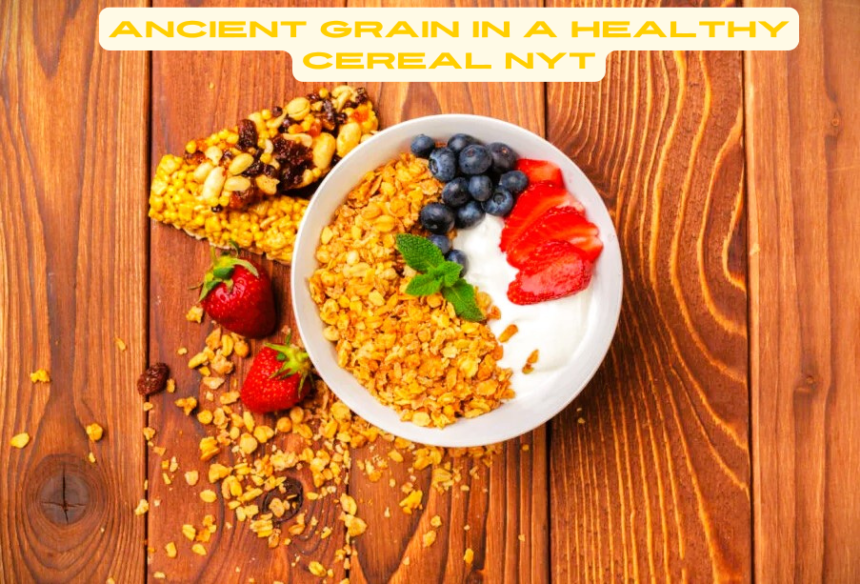Today we are talking about ancient grain in a healthy cereal nyt. In recent years, ancient grains have gained immense popularity as a core ingredient in healthy cereals, offering a nutritious and delicious way to start the day. Ancient grains, unlike refined grains, have been minimally modified over the years and retain their original form. As consumers increasingly seek out natural and nutrient-dense foods, ancient grains have become a favorite for those striving to maintain a balanced diet. In this article, we delve into the benefits of ancient grains, their nutritional value, and why they should be a staple in your daily cereal.
What Are Ancient Grain in a Healthy Cereal NYT?
Ancient grain in a healthy cereal nyt are grains that have remained unchanged for thousands of years, avoiding the extensive hybridization and modification that many modern grains undergo. They include varieties such as quinoa, amaranth, farro, spelt, and millet. Unlike modern wheat, corn, and rice, which have been bred for higher yields and easier processing, ancient grains have preserved their nutritional integrity, offering a unique balance of fiber, vitamins, and minerals.
These grains have a rich history and were central to the diets of ancient civilizations. For example, quinoa was a staple food of the Inca Empire, while farro and spelt were key grains in ancient Rome. Their resurgence today reflects a growing desire for whole, nutrient-dense foods that offer more than just calories—they provide essential micronutrients and have numerous health benefits.
Nutritional Benefits of Ancient Grain in a Healthy Cereal NYT
Ancient grains are celebrated not only for their history but also for their remarkable nutritional profile. Compared to their modern counterparts, ancient grains are often higher in protein, fiber, and essential amino acids, making them an ideal choice for a healthy cereal.
Rich in Fiber
One of the primary advantages of ancient grains is their high fiber content. Fiber is essential for maintaining a healthy digestive system, and a diet rich in fiber can help regulate blood sugar levels and reduce cholesterol. Incorporating ancient grains like barley and millet into your breakfast cereal provides a slow, sustained release of energy, helping you feel fuller for longer and preventing mid-morning hunger pangs.
High in Protein
Many ancient grain in a healthy cereal nyt, such as quinoa and amaranth, are considered complete proteins, meaning they contain all nine essential amino acids that the body cannot produce on its own. This makes them a valuable source of plant-based protein, especially for those following a vegetarian or vegan diet. By including these grains in your cereal, you’re ensuring that your body receives the building blocks it needs for muscle repair and overall health.
Packed with Antioxidants
Ancient grains are rich in antioxidants, which play a vital role in protecting the body from oxidative stress and inflammation. For instance, freekeh, a type of roasted green wheat, contains high levels of lutein, an antioxidant known for promoting eye health. Additionally, sorghum is abundant in phenolic compounds, which have been shown to reduce inflammation and lower the risk of chronic diseases.
Source of Essential Minerals
Many ancient grains are excellent sources of key minerals such as magnesium, iron, and zinc. These minerals are crucial for maintaining healthy bones, supporting the immune system, and promoting proper nerve and muscle function. For example, teff, a tiny grain originating from Ethiopia, is exceptionally high in calcium, making it a great choice for maintaining strong bones and teeth.
Why Choose Ancient Grain in a Healthy Cereal NYT?
Choosing a cereal made with ancient grains is a simple yet powerful way to improve your daily diet. Not only do these grains offer superior nutrition, but they also provide a range of textures and flavors that make breakfast more enjoyable.
Lower Glycemic Index
Many ancient grains have a low glycemic index (GI), which means they cause a slower, steadier rise in blood sugar levels. This is particularly beneficial for individuals managing diabetes or those looking to maintain stable energy levels throughout the day. By incorporating low-GI grains like buckwheat or barley into your cereal, you can avoid the rapid spikes and crashes in blood sugar that are often associated with more processed, refined grains.
Gluten-Free Options
For those with gluten sensitivities or celiac disease, many ancient grains offer a nutritious alternative to wheat-based cereals. Grains such as quinoa, amaranth, teff, and sorghum are naturally gluten-free, allowing individuals to enjoy the benefits of ancient grains without experiencing the adverse effects of gluten.
Versatile and Flavorful
Ancient grains are known for their rich, earthy flavors and diverse textures. Whether you prefer the chewy texture of farro or the nutty flavor of spelt, there is an ancient grain to suit every palate. Mixing different grains in your cereal can create a complex and satisfying taste experience, elevating your breakfast to something far more exciting than a bowl of processed cereal.
Top Ancient Grains to Include in a Healthy Cereal
There are several ancient grains that stand out for their exceptional nutritional value and versatility. Here are some of the best options to consider when crafting a healthy cereal:
Quinoa
Quinoa is one of the most popular ancient grains due to its complete protein profile and high levels of fiber, magnesium, and B-vitamins. It has a light, fluffy texture and a mild, slightly nutty flavor, making it a perfect base for any cereal.
Amaranth
Rich in protein and fiber, amaranth is another gluten-free grain with a slightly sweet, earthy taste. It is particularly high in lysine, an essential amino acid that plays a role in calcium absorption and tissue growth.
Farro
Farro is a type of wheat with a chewy texture and a rich, nutty flavor. It is packed with fiber, protein, and magnesium, making it a hearty and satisfying addition to any cereal.
Millet
Millet is a gluten-free grain that is high in antioxidants and magnesium. Its mild, slightly sweet flavor pairs well with both sweet and savory ingredients, making it a versatile choice for breakfast.
Spelt
Spelt is an ancient form of wheat that is easier to digest than modern wheat. It has a nutty, slightly sweet flavor and is rich in protein, fiber, and several B-vitamins.
Teff
Teff is a tiny grain native to Ethiopia and is one of the most nutrient-dense ancient grains. It is an excellent source of calcium, iron, and protein, and its earthy flavor makes it a great addition to porridge-like cereals.
Conclusion
Incorporating ancient grain in a healthy cereal nyt is a fantastic way to boost the nutritional value of your breakfast and enjoy a range of health benefits. From high fiber content to complete proteins, these grains offer a nutrient-dense, flavorful alternative to the processed cereals that dominate grocery store shelves. Whether you are looking to improve your digestive health, manage your blood sugar levels, or simply enjoy a more flavorful breakfast, ancient grains are a powerful addition to any diet.






